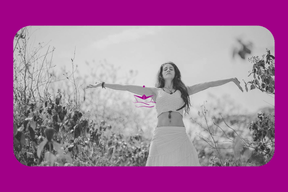Can Belly Dance Be a Tool for Well-Being?
As someone who respects every piece of knowledge taught to me through education and the experiences of daily life, but who ultimately turns to what emerges from within myself, I’ve been dancing with my belly for some time to live and release my emotions.
We, in the Western world, have created an ideal image of a healthy body and, with our dogmatic tendencies, declared it as our only truth. This ideal body generally involves being fit, strong, lean, and perhaps muscular. Movement practices were organized to achieve these outcomes for the body, and sports—even yoga and dance—were often used merely as formal tools. Even many practices intended for meditation became trapped in the anxiety of performance and formality, and we couldn’t reach “there.”
At this point, I began to experience dance as more than just a formal tool, but as an expression from within, a path to myself. Belly dance started to emerge naturally in my body. While I was studying contemporary dance at university, I organically evolved into a belly dance instructor and eagerly started to delve deeper into this field.
First, under the guidance of my dear teacher Berrak Yedek, I spent time exploring the ancient, traditional, and emotional side of belly dance. Indeed, the music, the space, and my belly opened the doors to a magical realm, and I would lose myself there. Then, as a body researcher, I decided to combine my knowledge within this realm and professionalize it. I started to detail my observations and studies and share them with those interested.
I remember my eyes lighting up when, during my Yin Yoga teacher training based on Qi Gong, my anatomy teacher, the wonderful Dr. Soner Özsu, said that the healthiest physical practice we could do is belly dance. Indeed, while performing movement practices, we tend to focus only on our muscles and joints, ignoring a large part of the body. Yet when we move, our fascia, nerves, and organs—everything that holds the structure of the body together—move with us. In other words, the whole “us” moves. We engage in movement as a physical, emotional, mental, and spiritual whole. I cannot engage in any action while excluding a part of myself. I am a whole being.
Belly movements are the most effective way to reach the etheric nervous system, also called the second brain. We, as beings with a highly developed frontal lobe, often struggle to access our archaic consciousness, our subconscious in a way. The plexus nerve network, the etheric nervous system, also known as the solar plexus and sacral chakra, offers us knowledge of our most ancient, deepest selves. Additionally, through belly dance, we touch our internal organs and provide them with movement support to function healthily. With belly dance, we reach hidden places in our bodies (both anatomically and emotionally) that we can’t access with other practices, essentially giving ourselves an internal massage. This internal massage offers many benefits, such as improved circulation, organ health, fascia relaxation, and nervous system regulation.
Considering that about 95% of serotonin, the hormone known to bring us happiness, vitality, and energy, is produced in the gut, we can scientifically understand how belly dance contributes to our mood.
Moreover, belly dance, known as the dance of abundance, fertility, and prosperity, helps activate our life force (libidinal energy). It creates space for the softening and release of sexual blockages that we may experience for various reasons. We remember the poetry of the body and surrender to the power of the tribal. Indeed, we can see belly dance not merely as a dance of the belly but as a language that celebrates the poetry of the body. This language can be a modern, simple, and accessible method for connecting with our belly, our sexuality, and life itself.
Everyone can experience this creation, and everyone can dance on their own. However, for those who want to dance more consciously, I offer improvisation-technical workshops and write lessons focused on understanding and living the body within a structured curriculum. While belly dance may not be a definitive key to the “well-being” state we idealize today, I’m certain that it is an incredible resource for cultivating “the courage to be ourselves,” “the freedom to move according to our own truth,” and “an honest relationship with our body.”
In fact, for me, well-being isn’t about the utopia of constantly feeling good but rather encompasses these three qualities. By focusing on the “being” part of well-being—our existence—we can live a much more meaningful life.
Here’s to the days when we can embrace, with compassion, all the joys and sorrows of our belly, the source that connects us to life and also represents our first separation, through our belly button.


